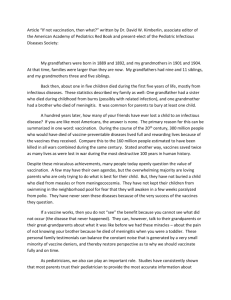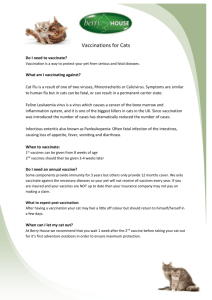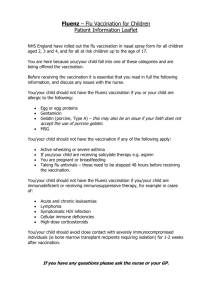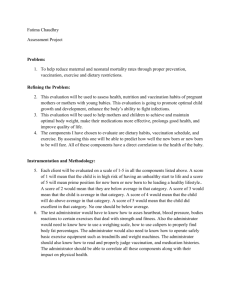Modelling the Spread of Infectious Diseases
advertisement
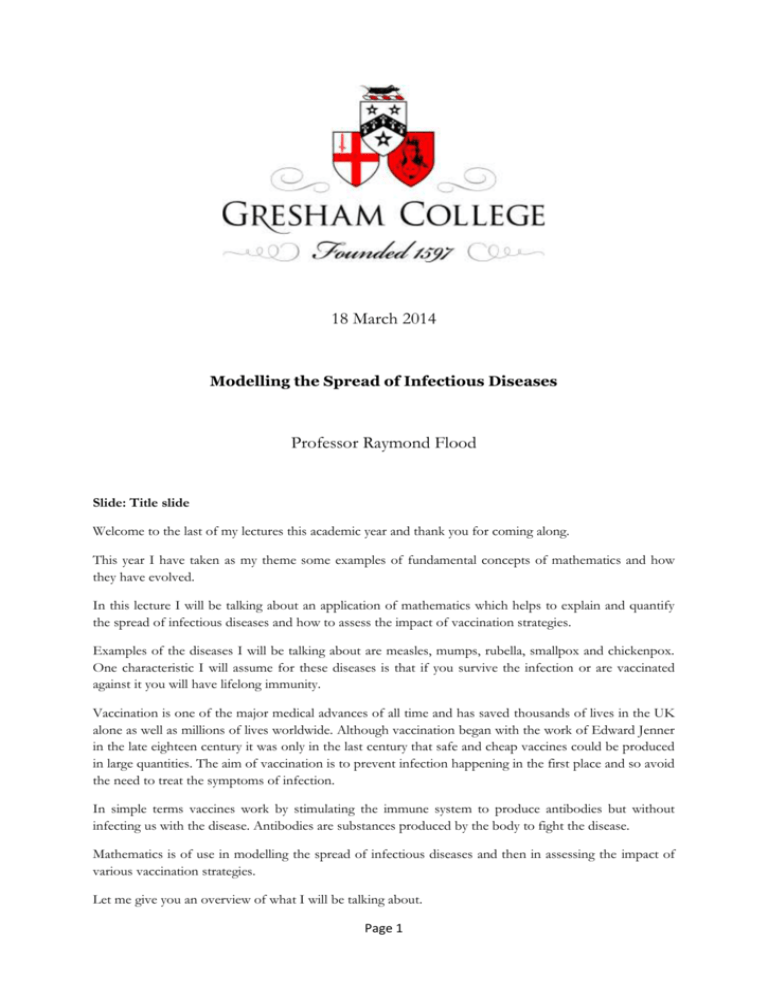
18 March 2014 Modelling the Spread of Infectious Diseases Professor Raymond Flood Slide: Title slide Welcome to the last of my lectures this academic year and thank you for coming along. This year I have taken as my theme some examples of fundamental concepts of mathematics and how they have evolved. In this lecture I will be talking about an application of mathematics which helps to explain and quantify the spread of infectious diseases and how to assess the impact of vaccination strategies. Examples of the diseases I will be talking about are measles, mumps, rubella, smallpox and chickenpox. One characteristic I will assume for these diseases is that if you survive the infection or are vaccinated against it you will have lifelong immunity. Vaccination is one of the major medical advances of all time and has saved thousands of lives in the UK alone as well as millions of lives worldwide. Although vaccination began with the work of Edward Jenner in the late eighteen century it was only in the last century that safe and cheap vaccines could be produced in large quantities. The aim of vaccination is to prevent infection happening in the first place and so avoid the need to treat the symptoms of infection. In simple terms vaccines work by stimulating the immune system to produce antibodies but without infecting us with the disease. Antibodies are substances produced by the body to fight the disease. Mathematics is of use in modelling the spread of infectious diseases and then in assessing the impact of various vaccination strategies. Let me give you an overview of what I will be talking about. Page 1 Slide: Overview of the lecture Compartment models As we will be considering diseases which if you survive them you then have lifelong immunity it is natural to divide the population into three compartments – those susceptible to the disease, those infected with the disease and those recovered and therefore immune from the disease. People can move between categories, for example a susceptible person can become infected and an infected person could recover and become immune. Also people can join the susceptible compartment usually by being born. And of course death causes you to leave the population! Reproductive rates To make any further progress we need to quantify the transfer rate between the various compartments and the birth and death rates for the population. Crucial to this progress is the idea of the basic reproductive rate. The basic reproductive rate is the number of secondary cases produced by one infected person when all the population is susceptible. Different infections have different basic reproductive rates. This is because different infections vary in, for example, the ease with which they are transmitted and for the length of time for which a person remains infectious. The basic reproductive rate also can vary between populations because of different social behaviours, for example the frequency and nature of contacts between individuals. Average age of infection The basic reproductive rate is hard to observe and evaluate. We can use our simple compartment model to show how the basic reproductive rate is related to the average age at which people get the infection. Essentially we will show the intuitively obvious result that the larger the basic reproductive rate the lower the average age at which the infection is acquired. Indeed we will see that the average age of infection is inversely proportional to the basic reproductive rate so doubling the basic reproductive rate halves the average age at which infection is acquired. Later I will introduce more complicated models and it can be shown that the same relationship still holds between basic reproductive rate and average of infection. Waves of infection I will set up a simple model for this movement between the susceptible, infected and recovered compartments and, using a spreadsheet, see how the model explains epidemics or regular cycles or waves of disease. We will also see that even though the model is very simple it mimics observed patterns. Jenner, vaccination and eradication In this section on vaccination I will give you a little background about Edward Jenner. Jenner was an English doctor, the pioneer of smallpox vaccination and often called the father of immunology. Vaccination has been very important not only in saving lives but in improving the quality of life. Page 2 I will find the critical proportion of the population that it is necessary to vaccinate to eradicate an infection. It is a simple expression involving the basic reproductive rate of the disease. If we cannot achieve this critical proportion then vaccinating a lower proportion does reduce the number infected but also raises the average age at which infection is acquired compared to the average age before the start of the vaccination campaign. This increase in average age can be significant for a disease like rubella or German measles which if caught later in life when a woman is pregnant can cause serious disorders to the baby if it is acquired during the first 20 weeks of pregnancy. Beyond the simple models My last section will indicate some improvements that could be made to the basic model I have used and consider what to do whenever a vaccine does not provide lifelong immunity and consider how vaccination might be used in a future outbreak of foot and mouth disease in livestock. Slide: compartment models Here the population is divided into three compartments: S is the collection of susceptible people and we will also use it, S, to denote the number of susceptible people. I is the collection of infected people and we will also use it, I, to denote the number of infected people. R is the collection of recovered people and we will also use it, R, to denote the number of recovered people. This is frequently known as the SIR model. A person will move from the susceptible compartment to the infected compartment if they acquire the disease and on recovery will leave the infected compartment and enter the compartment of those who have recovered and we will assume subsequently have lifelong immunity. So we need to think of the quantities S, I and R as varying with time. The model also has other inputs and outputs. The most important ones are births and deaths. Slide: Compartment Model – add births An obvious way of adding births to the model is to use the birth rate, b, for the population. For the United Kingdom, for example, the birth rate is about 12 births per thousand adults per year. So the birth rate per person in the United Kingdom is 0.012 per year. Then if b is the birth rate, N is the total population, which is S + I + R, the number of births is bN and we make the assumption that all of these enter the susceptible compartment. In the UK, if we take the population as about 60 million then the number of births is 60 million times 0.012 which is 720,000 births per year. Page 3 Slide: Compartment Model – add deaths But there are also deaths as well as births and in this slide I distinguish two death rates which I call the natural death rate, affecting all compartments and the disease induced death rate which only affects compartment I. An example giving a disease induced death rate is measles. As the World Health organisation states in a factsheet issued last month: Measles is still common in many developing countries – particularly in parts of Africa and Asia. More than 20 million people are affected by measles each year. The overwhelming majority (more than 95%) of measles deaths occur in countries with low per capita incomes and weak health infrastructures As high as 10% of measles cases result in death among populations with high levels of malnutrition and a lack of adequate health care. http://www.who.int/mediacentre/factsheets/fs286/en/ If there is little disease induced death we can work with the overall average death rate. In the United Kingdom this was about 12 per thousand per year in 1961 and has dropped to just over 9 per thousand per year in 2013. Of course it is possible to modify the compartment model in very many ways. Slide: Modifications of compartment model Some are: Add a latent compartment of people who are infected but not yet infectious. Tuberculosis might be an example. For some diseases maternal antibodies may protect for the first three to nine months so infants are born into a new protected compartment and lose immunity in the first year. Immunity may be lost, not lifelong, for example vaccination against influenza. You can build in the age structure of the population so that you would know how many people there were at each age in each compartment. This can be important for modelling sexually transmitted diseases. We could then also divide the compartments into male, female to consider diseases such as mumps and rubella which have different effects on males and females at different ages But we will stay with our relatively simple model shown again here. Slide: Compartment Model – add deaths I want to discuss the transmission dynamics between categories, particularly from the susceptible to the infected. To do this I am going to introduce one of the most important ideas and concepts in epidemiology of infectious diseases which is that of reproductive rates. Page 4 Slide: Basic reproductive rate. The basic reproductive rate, R0, is the number of secondary cases produced on average by one infected person when everyone in the population is susceptible. So R0 gives the average number of new cases if one infectious person is introduced into a completely susceptible population. R0 combines the biology of the infection with social and behavioural factors influencing contact rates. Slide: Basic reproductive rate with table Infection Basic Reproductive rate, R0 Measles 12 – 18 Pertussis 12 – 17 Diphtheria 6–7 Rubella 6–7 Polio 5–7 Smallpox 5–7 Mumps 4–7 This table gives the basic reproductive of some common infectious diseases in decreasing size of basic reproductive number. Measles and pertussis (commonly known as whooping cough) are very infective with a range between 12 and 17 or 18. There is such a variation in the range of R0 because of measuring it in different places and societies with consequent variation in contact rates. Diphtheria and Rubella (also known as German measles) are about the same while polio, smallpox and mumps are slightly lower. The basic reproductive rate is, as I have said, is the average number of new cases of the infection when an infective is placed in a completely susceptible population. But in practice this is not what happens. Not all the population will be susceptible some will be immune, others will be already infected, and this leads us to the definition of the effective reproductive rate. Slide: Effective reproductive rate. The effective reproductive rate, R, is the number of secondary cases produced on average by one infected person when S people out of the population of N people are susceptible i.e. when not all the population is susceptible. There is a very important relationship between these two reproductive rates. It is that Page 5 R = R0 𝑆 𝑁 If we assume random mixing of the population, often called homogeneous mixing, then the number of 𝑆 new people infected caused by an infectious person will be R0 multiplied by the proportion 𝑁 which is the fraction of the susceptible people in the population. Note that if S = N then R is the same as Ro which is what you would want. R is crucial to the pattern of the disease. If R is greater than or equal to 1, so that each infected person produces 1 or more infected before recovering or dying then the disease will persist i.e. be endemic within the population. But if R is less than 1 then the disease will die out even if there are still susceptible people in the population. Now let us update our compartment model. Slide: Compartment model – add transfer from susceptible to infected This transfer rate from susceptible to infected is just RI. This is simply because each infected person causes R other infections and there are I infected so the number of new infections is RI. Because the basic reproductive rate is difficult to observe and evaluate as it involves the number of new cases when all are susceptible we will use our compartment model to show how the basic reproductive rate is related to the average age at which people get the infection. Essentially I will show the intuitively obvious result that the larger the basic reproductive rate the lower the average age at which the infection is acquired. Indeed we will see that the average age of infection is inversely proportional to the basic reproductive rate. Because the basic reproductive rate of measles is roughly double that of rubella, the average age when measles is acquired is roughly half that of when rubella is acquired. First I want to say a little about rates at which an event occurs. Slide: Aside on rates It turns out that if a particular event, say death, occurs at a certain rate in time then the average time that you have to wait for the event to occur is 1 over the rate. The proof of this makes certain probability assumptions but it is frequently a useful approximation. For example if the death rate is per week then the average time to death or what is the same thing the average lifetime is 1/ weeks. If the infection rate is β per week then the average time to infection or the average age of acquiring infection is 1/β weeks. I am going to use this result soon. Let us now find the connection between the average age of infection and the basic reproductive rate. Page 6 Slide: Average age of infection 1 We are going to consider the situation when the disease is in a steady state. Then R = 1 and each infected produces another infected before recovering or dying so the disease is in a steady state. Remember R = R0 𝑆 𝑁 so 1 = R0 𝑆 𝑁 giving R0 = 𝑁 𝑆 Slide: Average age of infection 2 Then the number of people entering compartment S, that is the number being born must equal the number of people leaving it that is the number becoming infected so I = bN. Slide: Average age of infection 3 Use this to eliminate N. R0 = 𝑁 𝑆 𝐼 1 1 = 𝑏𝑆 = 𝑏 / 𝐼 ⁄𝑆 As we are taking a steady state the birth rate equals the death rate. Also 𝐼 𝑆 is infection rate. Putting these together with the earlier slide on rates gives: Slide: Average age of infection 4 𝑎𝑣𝑒𝑟𝑎𝑔𝑒 𝑙𝑖𝑓𝑒𝑡𝑖𝑚𝑒 𝑖𝑛 𝑡ℎ𝑒 𝑝𝑜𝑝𝑢𝑙𝑎𝑡𝑖𝑜𝑛 R0 = 𝑎𝑣𝑒𝑟𝑎𝑔𝑒 𝑎𝑔𝑒 𝑎𝑡 𝑤ℎ𝑖𝑐ℎ 𝑖𝑛𝑓𝑒𝑐𝑡𝑖𝑜𝑛 𝑖𝑠 𝑎𝑐𝑞𝑢𝑖𝑟𝑒𝑑 Slide: Table from Anderson and May on average age of acquiring infection Here is a table showing the average age at infection, A, for various childhood diseases in different geographical localities and time periods. There is a lot of variation by country. Measles can vary between about 5-6 in the USA in the 1950s to 1-2 in Senegal in the next decade. Also the average age that polio was acquired in the USA was high at 12-17 in 1955. Page 7 Now let me turn to how the SIR model can be used to explain epidemics or regular cycles or waves of disease. Slide: Incidence of Measles in US and in England and Wales These graphs show the incidence of measles in England and Wales and in the United States over the period from 1950 to 1982. Concentrate on the left hand portion of the graphs before vaccination was introduced. The incidence varies both from season to season and over longer periods. The seasonal trend is in part determined by patterns in social behaviour such as the timing of school holidays. A well-known example of longer term fluctuations taking place on a time scale of greater than one year are the two to three year cycles for measles. Indeed many directly transmitted viral infections such as measles typically have such a pattern of recurrent epidemic largely because the susceptible population varies. First the number of susceptible people goes down as immunity is obtained by recovering from infection and then the number of susceptible people increases as children are born. Slide: Model of waves of disease The compartment model I’ve introduced can explain this behaviour using only the basic reproductive rate of the disease, the birth rate of the population and the average duration of infectiousness of the disease. We will divide the time scale into successive intervals of length equal to the length of time an individual is infectious which is roughly one week for measles. So we are dividing the timescale into weeks denoted by n = 1, 2, 3 and so on and each case only lasts a week the child recovers and immunity is conferred. S(n) = the number susceptible at the start of week n I(n) = the number infected at the start of week n From the compartment model S(n + 1) = S(n) + bN - R0 𝑆(𝑛) 𝑁 I(n) Page 8 I(n + 1) = R0 𝑆(𝑛) 𝑁 I(n) where b is now the birth-rate per week, because a week is our time interval and N is the population size. Slide: Measles: birth rate 12 per 1000 per year I have run the simulation for 780 weeks so about 15 years and there are 7 peaks so the inter-epidemic period is 2 to 3 years. Not let us increase the birth rate threefold to 36 per 1000 per year, perhaps to reflect a developing country. Slide: Measles: birth rate 36 per 1000 per year Now there are 11 peaks so the inter-epidemic period has dropped to just over a year. The SIR model is usually presented as a system of differential equations but the same result can be obtained from them. Slide: Inter-epidemic period We can show that the period = 2 √𝐴 where A = average on infection = average interval between an individual acquiring infection and passing it on to the next person. A years years Period Measles 4-5 1/25 2–3 Whooping cough 4-5 1/14 3–4 Rubella 9 - 10 1/17 5 Slide: Edward Jenner Jenner was an English doctor, the pioneer of smallpox vaccination and often called the father of immunology. He was born in1749, trained in London as a doctor and then practised for the rest of his life in his birthplace in Gloucestershire. Smallpox was one of the greatest killers of the time particularly among children. The folklore of the countryside was that milkmaids who suffered the mild disease of cowpox never contracted smallpox. Page 9 In 1796, Jenner carried out a now famous experiment on eight-year-old James Phipps. Jenner inserted material taken from a cowpox pustule into an incision on the boy's arm. Jenner subsequently showed that this inoculation of the boy with cowpox gave immunity to smallpox. Initially his ideas met with a lot of resistance and Jenner experimented on several other children, including his own 11-month-old son. In 1798, his results were finally published and Jenner coined the word vaccine from the Latin 'vacca' for cow. Slide: Cartoon In this caricature The Cow-Pock—or—the Wonderful Effects of the New Inoculation! of 1802, James Gillray caricatured recipients of the vaccine developing cow-like appendages. Critics, especially the clergy, claimed it was repulsive and ungodly to inoculate someone with material from a diseased animal. But the obvious advantages and protection of vaccination became obvious and it soon became widespread. One of the greatest achievements of public health policy was the global eradication of smallpox. This was confirmed by the World Health Assembly on 8 May 1980 when it declared solemnly that: the world and its peoples have won freedom from smallpox, which was a most devastating disease sweeping in epidemic form through many countries since earliest time, leaving death, blindness and disfigurement in its wake and which only a decade ago was rampant in Africa, Asia and South America. Mass vaccination as a means of controlling diseases has two main effects. Most obviously there is the direct effect that those effectively immunised are protected against infection. The second and indirect effect which is less obvious arises because a susceptible individual has less chance of acquiring the infection in a partially vaccinated community than in an unvaccinated population: there are fewer people around who can give the person the disease, thus it is not necessary to immunise everyone to eradicate the infection. This is known as herd immunity. We can easily calculate the critical vaccination rate to eliminate the disease and provide herd immunity. Slide: Critical vaccination rate, pc Need to vaccinate a large enough fraction of the population to make the effective reproductive rate, R, less than 1. 𝑆 𝑆 As R = R0 𝑁 need to reduce S so that R0 𝑁 is less than 1. Need to make the fraction susceptible, 𝑆 , 𝑁 1 less than 𝑅 . 0 1 So vaccinate a fraction of at least 1 - 𝑅 of the population. 0 1 Critical vaccination rate, pc is greater than 1 - 𝑅 0 Page 10 This critical vaccination rate can also be derived from the compartment model and is the threshold that prevents the spread of a newly introduced infectious disease and the threshold that eradicates an existing infectious disease. Slide: critical vaccination for measles, whooping cough and rubella For measles and whooping cough R0 is about 15 so pc about 93%. Another way of thinking about this is that we want the number of susceptible to be 1/ R0 of the total population which in the UK is about 4 million. For rubella R0 is about 8 so pc about 87% These are the critical vaccination rates if vaccination at birth. We need a larger percentage if vaccination occurs later. If vaccination occurs at age 2 then we need approximately 95% coverage to eradicate measles and whooping cough and this is the World Health Organisation target. Slide: Graph from Keeling et al article Here is a graph of critical vaccination rate against basic reproductive rate for various diseases: - influenza, SARS (Severe Acute Respiratory Syndrome), smallpox, rubella, chickenpox and measles. Slide: Measles in England & Wales and in the US Now look at the right hand side of these charts for the pattern after vaccination was introduced. The critical vaccination rate for measles is very high. In the United States the childhood immunisation initiative began in 1977, although widespread vaccination began much earlier and resulted in more than 95% of children in the United States being vaccinated against measles and whooping cough before they enter school. We can see the effect of the strategy at the top on the right hand side of the slide where the number of yearly notifications of measles in the United States declined considerably. In the United Kingdom immunisation at such high levels of vaccine coverage have proved difficult to achieve. Although immunisation in England and Wales has had an effect on the number of yearly notifications of measles it has not been such a substantial effect as was achieved in the United States. The tendency for the incidence of disease to oscillate in a regular manner raises a further problem in assessing the benefits of mass immunisation. If vaccination coverage is high the non-seasonal epidemics will be small and it will be difficult to distinguish epidemic from non-epidemic years. However under low to moderate levels of vaccination there may still be more cases in an epidemic year than there were in non-epidemic years before vaccination. Thus in any assessment of the risk of exposure to infection we should base our calculations on the average risk over the Inter-epidemic period covering years of low and high risk. Page 11 Slide: Measles: vaccination rates Here I have some more up to date figures. On the right in the slide I show MMR (mumps, measles and rubella) vaccination coverage in England at 24 months of age for the years from 1992 to 2012. It has stayed below 92% and dropped to below 80% in 2003/4. These numbers show how hard it is to eradicate certain childhood diseases. The vaccination needs to cover a very large fraction of the population. Also the calculations assume that a vaccine gives 100% protection, which might not always be the case. We have also seen a potential conflict between the interests of the individual and the interests of the community. If a vaccine can have side effects parents might decide not to have their children vaccinated, especially if the risk of infection is very low. But the risk of infection is very low only because so many children are vaccinated. Hence, from the perspective of the individual it may be rational not to vaccinate one's children but to have all or most other children vaccinated but if this is a widespread adopted decision it can lead to loss of herd immunity and increase in the spread of infection – and we know that some of these diseases can have severe consequences. I want to look now at the effect vaccination can have on the average age at which the infection is acquired. Vaccination essentially has the effect of lowering the effective reproduction number by decreasing the number susceptible in the population and we can show that this has the effect of increasing the average age of infection. Slide: Vaccinating below the subcritical level increases the average age at which infection is acquired. Using the model I’ve described we can show that if we vaccinate a proportion p of the population which is a proportion below that required to eliminate the infection then in the steady state Average age of infection after vaccination = Average age of infection before vaccination 1–p Thus although the protection through vaccination leads to a lower number of infections it may be an unwanted side effect that it also increases the average age of infection. This could be unwanted because some childhood infections have more severe effects when they occur in older individuals. Rubella, for example, can lead to severe complications during pregnancy while mumps in adolescent and adult males can cause intense discomfort. This increase in the average age of infection means that effects of vaccination policies on the population need to be carefully investigated for any new vaccination policy. Not let me move to my final section. Page 12 Slide: Beyond the simple model In an issue last year of the Institute of Mathematics and its Applications publication Mathematics Today there was an interesting article on the mathematics of vaccination by a group from Warwick University. I will finish by describing some of the issues they considered. First note that the simple SIR model that we have been considering does not capture all the complexities of human populations and how they interact. Also our assumption of homogeneous or random mixing does not reflect the fact that people tend to mix more with others of a similar age. It is also the case that the young and the old suffer more from the consequences of infectious diseases. What is perhaps surprising is that when more complicated age structured compartment models are used the critical vaccination proportion we have derived still holds. It is still the case that it is sufficient to 1 randomly immunise a proportion 1 - 𝑅 of the population in order to eradicate the infection. 0 However it might be possible in some situations to control the infection more efficiently by targeting the vaccination at appropriate subgroups of the population rather than randomly vaccinating a certain proportion of the population. Slide: Other factors and approaches I want to consider four other factors and approaches. • Vaccines are not perfect • Optimal vaccination • Optimal vaccination in households • Optimal vaccination in space Slide: Vaccines are not perfect In practice, it might be the case that the vaccine is not perfect. For example, it may fail to give protection to a certain proportion of people who receive it. In that case in order to eradicate the infection it will be necessary to vaccinate an even larger proportion that the critical proportion. Another way in which the vaccine may be less than perfect is that it provides only partial protection to the disease. This partial protection could work in many ways. For example it might reduce a person’s susceptibility to becoming infected rather than provide full protection. Or if the person does become infected it might reduce their propensity to passing on the infection. Or if the person does become infected it may influence the speed with which they recover from the infection. Such vaccines are called leaky. It is possible to incorporate such leaky vaccines into the compartment model by adding another compartment which contains those people who have been vaccinated but have not achieved full immunity. Page 13 We can work through the mathematics for this modified compartment model and find out what is the critical proportion of people that must be vaccinated in these circumstances in order to eliminate the infection. Slide: Optimal vaccination If a vaccine offers lifelong immunity, possibly after booster vaccines, the optimal procedure is to vaccinate at as early an age as possible. However if the period of immunity offered by the vaccine is short then it is important to target the vaccine at people who are most at risk. An example of a vaccine which provides limited duration of immunity is the HPV vaccine which protects against cervical cancer. It is thought that this vaccine offers protection for 5 to 10 years. Therefore it is important not to vaccinate girls too young because then the effects of the vaccine will be lost before the age of greatest risk. It is also important not to vaccinate them when they are too old because then they may have already contracted HPV. Mathematics can help with this balancing act between age related risk and behaviour with the impact vaccination can have in providing protection. Another example of a vaccine providing limited duration of protection is that for the influenza virus. The influenza virus is constantly changing and providing new challenges to the immune system. The question once again is to find which ages should be vaccinated to achieve maximum impact taking into account that the effects of influenza varies for different age groups in the population. This year children and young people between the ages of two and 17 are also going to be included in the seasonal vaccination campaign. This should have two effects. First of all it will protect children and young adults in this age group from influenza which can have serious effects for them. Secondly this age group is also a major source of transmission for influenza and so vaccination will stop them spreading the disease. The mathematical subject of optimisation theory is used to determine the appropriate targeting of vaccination. The aim is to try to maximise the benefits in terms of lives, preventing illness and treatment costs saved while minimising the costs in terms of buying and administering the vaccine. Slide: Optimal models of vaccination in households Up to now we have thought of the population as consisting of individuals, but it is more realistic to think of the population as a collection of households. Probably you are more likely to obtain an infection from a member of your household because of the frequency of interactions. Also households facilitate the spread of infections between generations. Thinking of a population of households rather than individuals is interesting mathematically but sometimes leads to conclusions are difficult to implement practically. Page 14 One recent situation in which analysis of the household structure was of benefit was in targeting vaccination during the recent swine flu pandemic. The approach was to generate herd immunity within households where there were people with weakened immune systems. Such people were vulnerable not only to the natural infection but also to the vaccine and the strategy was in the swine flu pandemic to vaccinate all household contacts of these individuals. Slide: vaccination in space In 2001 there was a major outbreak of food and mouth disease in the United Kingdom. By the end of the epidemic 6.5 million livestock had been destroyed and the economic cost was estimated at £5 billion. The United Kingdom government used a policy of culling of livestock in “at risk” farms to control the epidemic. This policy was very unpopular not only with the farming community but also with the general public. Vaccination was not used during the 2001 outbreak because the limited vaccination campaign that would have been possible then would have had very limited impact. However contingency plans for any future foot and mouth disease outbreak intend to use vaccination as part of its strategy. For vaccination during an outbreak to be effective it needs to be targeted to create a barrier around infected animals to isolate them from the susceptible members of the population. This barrier or ring around infected individuals or farms needs to be of such a size that the number of secondary cases produced on average falls to less than one. Mathematical models and computer simulations help in deciding on the critical size of the ring surrounding infectious cases. It is important to build logistical factors into these mathematical models. For example is it possible to vaccinate all cases in the ring on the day that an infectious animal is discovered? Or if there are many initial cases in different geographical areas is it possible to vaccinate all animals in the required ring around each case? In spite of these logistical difficulties ring vaccination around infected cases does have the potential to reduce the impact of future outbreaks of foot and mouth disease. In conclusion I hope that I have shown you that the use of mathematics can inform and influence the development and implementation of vaccination strategies. Thank you for coming today and in the words of Nick Ross of the television programme Crimewatch: Don't have nightmares, do sleep well Finally a note for your diary: September 16, 2014 when I start next year’s lectures, the details of which will appear in the Gresham College prospectus. © Professor Raymond Flood Page 15


